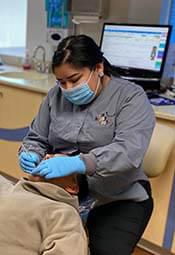With braces being such a common part of childhood, and now as they become more popular among adults, we are used to seeing them all around us. While we are familiar with how they look, we probably haven’t thought much about how they work. This may seem like something that doesn’t matter much, but it’s important to know how braces move teeth so you can understand how they work for you.
The parts of braces
Silver and clear braces are composed of three parts: brackets, arch wires, and ligatures. Brackets are the metal or ceramic squares attached to the front of your teeth, arch wires are the thin wires in front of the brackets, and ligatures are the small rubber bands attaching the archwires to the brackets. Ligatures are colored and can be changed at every appointment, which is how people are able to adjust the color of their braces based on holidays, school colors, personal preferences, etc.
How teeth move
Teeth are surrounded by gums and a tissue known as a periodontal membrane, with bone next to both of these. As the braces apply pressure, the membrane is stretched, which loosens your teeth slightly and allows them to move. Once they are moved to their new position, your body starts working to regenerate the bone that will hold them in place. While it only takes about 72 hours to move your teeth to a new position, it takes up to 90 days to regrow bone, then up to 10 additional months for the bone to be completely stabilized. It is this slow, gradual process that eventually moves your teeth to a straighter position.
How braces move teeth
Archwires and brackets are the heavy hitters when it comes to how braces move teeth. Archwires are designed to be activated by heat and to want to stay straight. When archwires are bent and attached to brackets, they will try to return to their original straight position. Since their stiffness is activated by heat, the temperature in your mouth will cause them to want to stay straight and stiff. The first batch of wires your orthodontist will attach are relatively loose and flexible. As you continue in the treatment, the wires will gradually become thicker and less flexible, exerting slightly more pressure on your teeth. This applied pressure gradually pulls your teeth into a better position, where they can begin to regrow bone.
Once your braces are removed, it is important to wear a retainer so your teeth don’t move back to their original position. For the first three to six months, you should wear your retainer most of the day–up to 22 hours. After this initial period, you’ll be able to transition to wearing the retainer only at night.
Getting braces is one of the more important things you can do for your health. It can help you prevent cavities, decrease teeth and jaw pain, and increase self confidence. If you feel ready to take this next step on your journey to health, contact myOrthodontist to schedule your free consultation!


